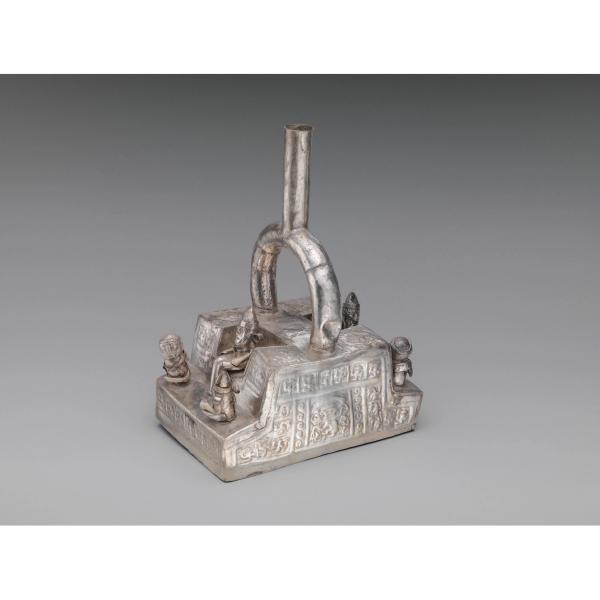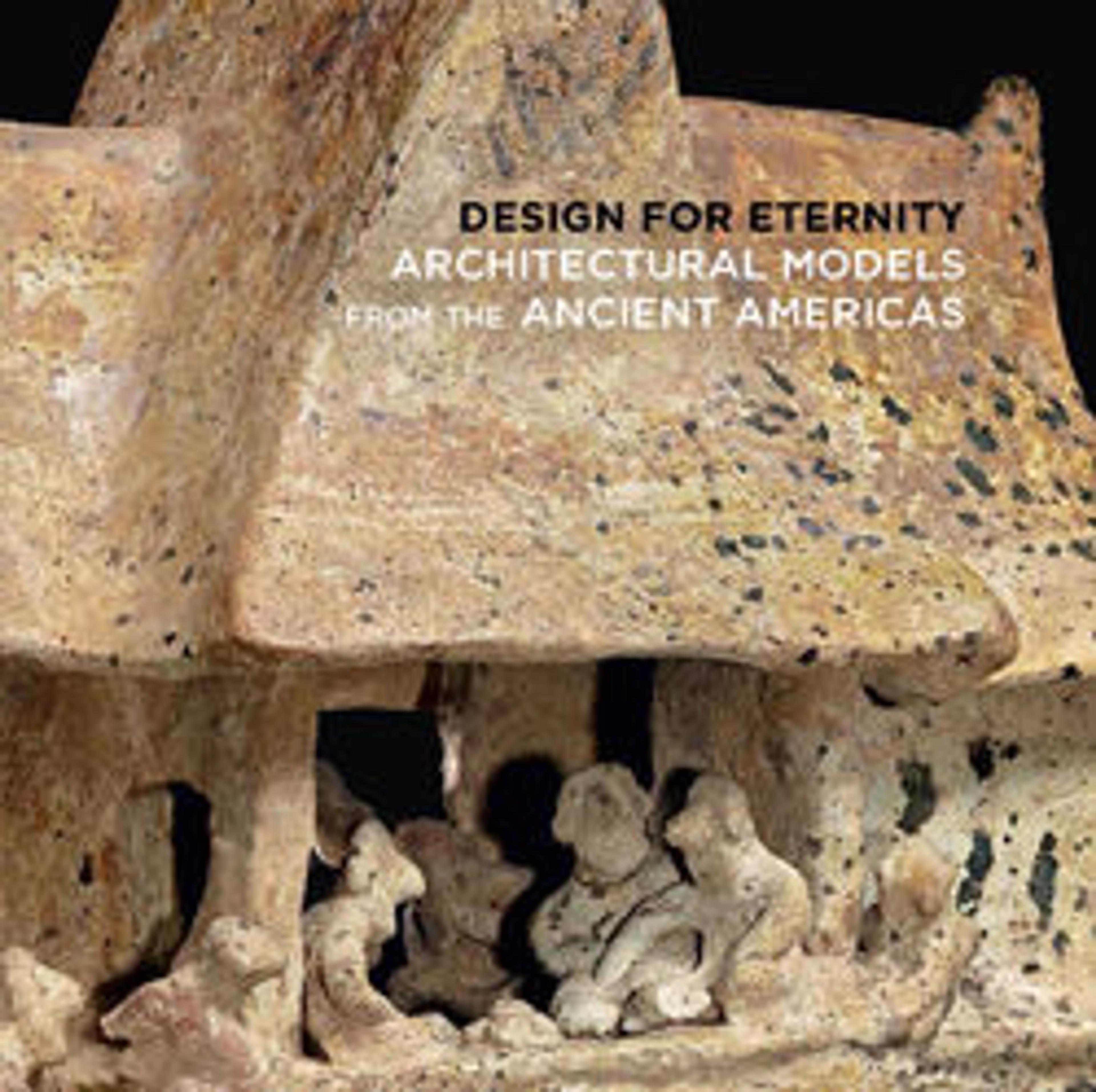Stirrup-spout bottle with palace scene
This bottle, made of pieces of silver sheet that were cut, embossed, and soldered together to create a vessel with a body in the shape of an architectural platform with figures, may have been meant to evoke an area within the Chan Chan palaces. A central figure with a conical headdress and large ear ornaments is shown seated within a niche-like space, flanked by two figures seated in front of him, one wearing a similar conical headdress and ear ornaments, and the other bearing what may be a sack over his shoulders. The scene is repeated on the opposite side of the vessel. The walls of the structure are decorated in the style of the Chan Chan palaces and other nearby structures such as Huaca el Dragón, with reliefs depicting figures with crescent headdresses and marine birds. The principal individuals are seated on throne-like audiencias—U-shaped structures that were often located adjacent to storage facilities. Whether the figures with sacks over their shoulders were intended to represent long-distance traders or bringers of tribute is unknown, but surely the scenes speak to some sort of interchange within the walls of this wealthy city.
Between the twelfth and fifteenth centuries, the Chimú kingdom dominated some 800 miles of Peru’s North Coast, from just south of the modern border with Ecuador to just north of Lima. The remains of Chan Chan, at the edge of the Pacific Ocean, encompasses some 8 square miles (20 km2). The royal compounds had high perimeter walls, grand open courtyards, walk-in wells, and ample storage facilities. These palaces had a single entrance, on the north perimeter wall, and progress through the palaces was impeded by a system of baffled entries, further restricting the flow of visitors into the compounds’ interiors. Sixteenth-century accounts of the looting of these palaces describe the immense quantities of riches they once held, including dozens of vessels of silver and gold. Few such works have survived to the present day, particularly works in silver—a metal that does not survive well in the archaeological record as it can deteriorate when exposed to salts and other minerals in the soil when buried. A rare survival of Chimú silverwork, this bottle speaks to a tradition for which the Chimú were once famed. That fame is reflected in the fact that shortly after the Chimú were conquered by the Incas, the silversmiths of Chan Chan were taken to Cusco, the Inca capital, where they were pressed into service of the newly dominant Inca Empire.
Joanne Pillsbury, Andrall E. Pearson Curator, Arts of the Ancient Americas, 2018
References and Further Reading
King, Heidi, Luis Jaime Castillo Butters, and Paloma Carcedo de Mufarech. Rain of the Moon: Silver in Ancient Peru. New York: The Metropolitan Museum of Art; New Haven, Conn.: Yale University Press, 2000.
Pillsbury, Joanne. “Imperial Radiance: Luxury Arts of the Incas and their Predecessors,” in Golden Kingdoms: Luxury Arts in the Ancient Americas, edited by Joanne Pillsbury, Timothy F. Potts, and Kim Richter, pp. 33-43. Los Angeles: The J. Paul Getty Museum, 2017.
Pillsbury, Joanne. “Reading Art without Writing: Interpreting Chimú Architectural Sculpture,” in Dialogues in Art History, from Mesopotamian to Modern: Readings for a New Century, Elizabeth Cropper, ed., pp. 72-89. Studies in the History of Art 74, Center for Advanced Study in the Visual Arts Symposium Papers LI. Washington D.C.: National Gallery of Art, Distributed by Yale University Press, 2009.
Pillsbury, Joanne, Patricia Sarro, James Doyle, and Juliet Wiersema. Design for Eternity: Architectural Models from the Ancient Americas. New York: The Metropolitan Museum of Art, 2015.
Artwork Details
- Title:Stirrup-spout bottle with palace scene
- Artist:Chimú artist(s)
- Date:1000–1470 CE
- Geography:Peru, North Coast
- Culture:Chimú
- Medium:Silver
- Dimensions:H. 9 1/4 x W. 4 3/8 x D. 6 1/2 in. (23.5 x 11.1 x 16.5 cm)
- Classification:Metal-Containers
- Credit Line:The Michael C. Rockefeller Memorial Collection, Gift of Nelson A. Rockefeller, 1969
- Object Number:1978.412.170
- Curatorial Department: The Michael C. Rockefeller Wing
Audio

1648. Botella de asa estribo con escena palaciega, artista(s) chimú
Joanne Pillsbury
JOANNE PILLSBURY: El palacio fue el lugar para el intercambio de bienes de alto nivel entre la élite, como los textiles y las obras de arte elaboradas en oro, plata y concha. Lo que vemos en esta vasija es un dignatario que lleva un tocado cónico y que está sentado en un nicho. Esta escena, donde el personaje está aparentemente hablando con otras dos figuras, se repite en el otro lado.
Soy Joanne Pillsbury. Soy curadora de las artes de las antiguas Américas en el Metropolitan Museum of Art.
JOSÉ MARÍA YAZPIK (NARRADOR): La forma de esta botella, su pico y asa en forma de estribo, la relaciona con una antigua tradición, mientras que el diseño la conecta con la ciudad de Chan Chán.
JOANNE PILLSBURY: Lo que vemos a los costados de la vasija muestra una gran similitud con la escultura arquitectónica de los palacios de Chan Chán. Vemos los mismos tipos de imagen: bandas de aves marinas, motivos ondulados... Este es el tipo de imágenes que los artistas chimú habrían representado en relieve de adobe en las paredes interiores de los palacios de Chan Chán.
JOSÉ MARÍA YAZPIK: Chan Chán, fundada alrededor del año 1000 de nuestra era, fue la capital imperial de los chimú.
JOANNE PILLSBURY: Esta era una ciudad llena de artistas. Creemos que tal vez hasta un tercio de los habitantes de la ciudad se dedicaban a la producción artesanal de algún tipo. Chan Chán era famosa por la calidad de su arte en metal.
JOSÉ MARÍA YAZPIK: El éxito y la fama de estos artistas pudo haber significado la ruina de Chan Chán. Los incas atacaron y saquearon la ciudad.
JOANNE PILLSBURY: Cuando los incas conquistaron Chan Chán, se llevaron cautivos a los orfebres. Fueron secuestrados y llevados a Cuzco, la capital inca. En lo alto de los Andes fueron puestos al servicio del Imperio Inca, que se encontraba en plena expansión. Este hecho nos recuerda que en las antiguas Américas, los artistas tenían una importancia tal que podían convertirse en botín de guerra.
More Artwork
Research Resources
The Met provides unparalleled resources for research and welcomes an international community of students and scholars. The Met's Open Access API is where creators and researchers can connect to the The Met collection. Open Access data and public domain images are available for unrestricted commercial and noncommercial use without permission or fee.
To request images under copyright and other restrictions, please use this Image Request form.
Feedback
We continue to research and examine historical and cultural context for objects in The Met collection. If you have comments or questions about this object record, please contact us using the form below. The Museum looks forward to receiving your comments.
